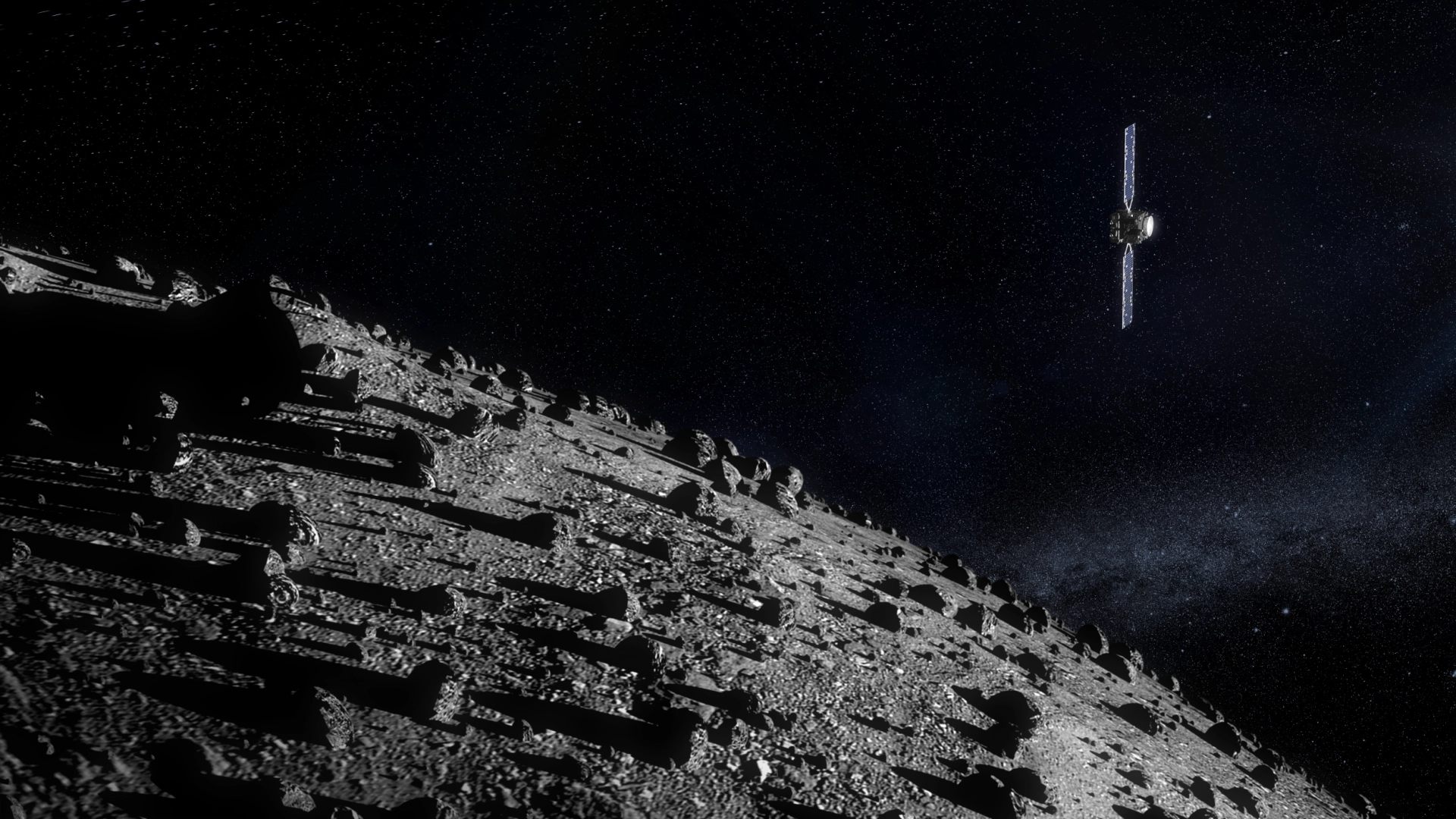Hera planetary defence mission successfully launched
- The European Space Agency’s mission will study the binary asteroid system formed by Didymos and Dimorphos, carrying out several experiments to better understand potentially hazardous asteroids
- The spacecraft took off on 7 October at 16:52 CEST from Florida (United States)
- IEEC researchers at the Institute of Space Sciences (ICE-CSIC) are involved in analysing images of the binary asteroid’s surface and also participated in NASA’s DART mission, Hera’s predecessor

Caption: Computer rendering of ESA’s Hera mission approaching the asteroid Dimorphos.
Credits: ESA-Science Office.
The European Space Agency‘s (ESA) Hera mission was launched successfully yesterday, 7 October, from the Cape Canaveral Space Force Station in Florida (United States) at 16:52 CEST. The mission, in which the Institute of Space Studies of Catalonia (IEEC — Institut d’Estudis Espacials de Catalunya) is participating with researchers at the Institute of Space Sciences (ICE-CSIC), will examine the binary asteroid system formed by Didymos and its satellite Dimorphos, after the DART planetary defence mission deflected the orbit of the latter.
On 26 September, 2022, NASA and Johns Hopkins University’s DART mission managed to slightly change the orbit of its target: the asteroid Dimorphos, which orbits the asteroid Didymos. This was the first planetary defence test mission designed to deflect the course of an asteroid. Now, Hera will visit this binary asteroid to map both in high resolution and characterise them. Hera will study the impact crater and the consequences of DART on Dimorphos, which will allow us to reconstruct its shape accurately, and to characterise its composition, structure, and nature.
Hera will reach the vicinity of this binary asteroid system in October 2026. By the time Hera reaches Didymos, it will be 195 million kilometres from Earth, although relative distances are constantly changing given that this asteroid system orbits the Sun.
Comprising a total of 12 instruments, including two CubeSats, Hera will help translate the kinetic impact method of deflecting potentially dangerous asteroids into an understandable and repeatable planetary defence technique. In addition, Hera will also test new autonomous navigation technologies in deep space and help deepen our understanding of asteroids.
“Hera is a necessary mission to better understand the response of a rubble-pile asteroid to a kinetic impactor,” says Josep M. Trigo-Rodríguez, IEEC researcher at the ICE-CSIC, who is participating in the Hera mission, and previously did so in the DART mission. “With it, we will answer countless questions about the structure and properties of these two potentially dangerous asteroids and, in fact, we will check whether the energetic impact of DART was reabsorbed by the pile of rocks or if, on the contrary, it was able to excavate a crater. A historic mission, together with DART, to make planetary defence against potentially dangerous asteroids a reality,” he adds.
His contribution is especially related to the interpretation of images and spectra of the surface of the asteroids Didymos and Dimorphos in order to identify the main physical processes that have contributed to shaping the surfaces of both and to analyse the consequences of the impact by the DART probe on the surface of Dimorphos.
Press release prepared in collaboration with the Institute of Space Sciences.
Contacts
IEEC Communication Office
Castelldefels, Barcelona
E-mail: comunicacio@ieec.cat
Lead Researcher at the IEEC
Castelldefels, Barcelona
Josep M. Trigo-Rodríguez
Institute of Space Studies of Catalonia (IEEC)
Institute of Space Sciences (ICE-CSIC)
E-mail: trigo@ieec.cat, trigo@ice.csic.es
About the IEEC
The Institute of Space Studies of Catalonia (IEEC — Institut d’Estudis Espacials de Catalunya) promotes and coordinates space research and technology development in Catalonia for the benefit of society. IEEC fosters collaborations both locally and worldwide and is an efficient agent of knowledge, innovation and technology transfer. As a result of more than 25 years of high-quality research, done in collaboration with major international organisations, IEEC ranks among the best international research centres, focusing on areas such as: astrophysics, cosmology, planetary science, and Earth Observation. IEEC’s engineering division develops instrumentation for ground- and space-based projects, and has extensive experience in working with private or public organisations from the aerospace and other innovation sectors.
The IEEC is a non-profit public sector foundation that was established in February 1996. It has a Board of Trustees composed of the Generalitat de Catalunya, Universitat de Barcelona (UB), Universitat Autònoma de Barcelona (UAB), Universitat Politècnica de Catalunya · BarcelonaTech (UPC), and the Spanish Research Council (CSIC). The IEEC is also a CERCA centre.
